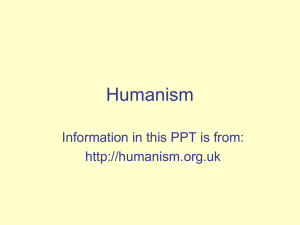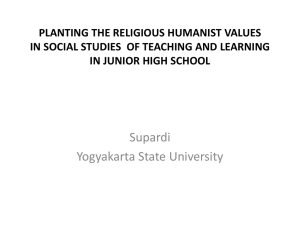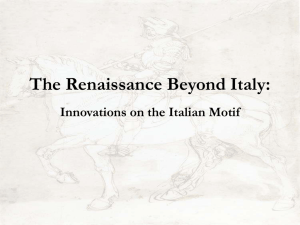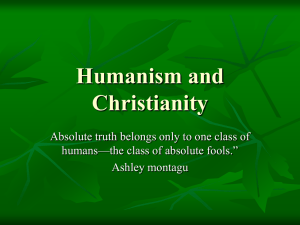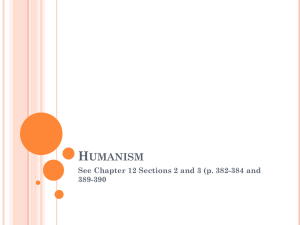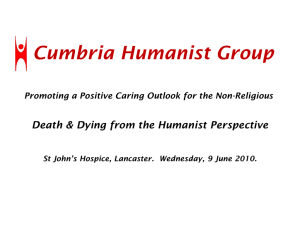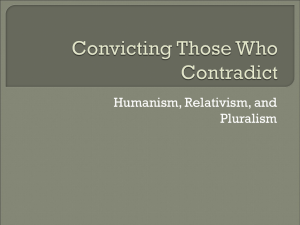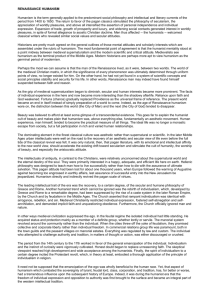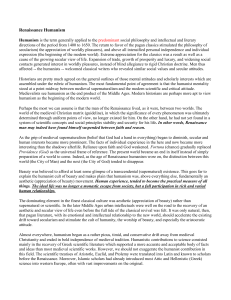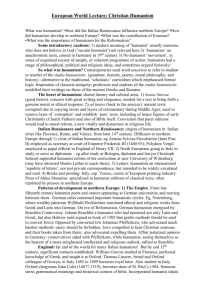Document 12950238
advertisement
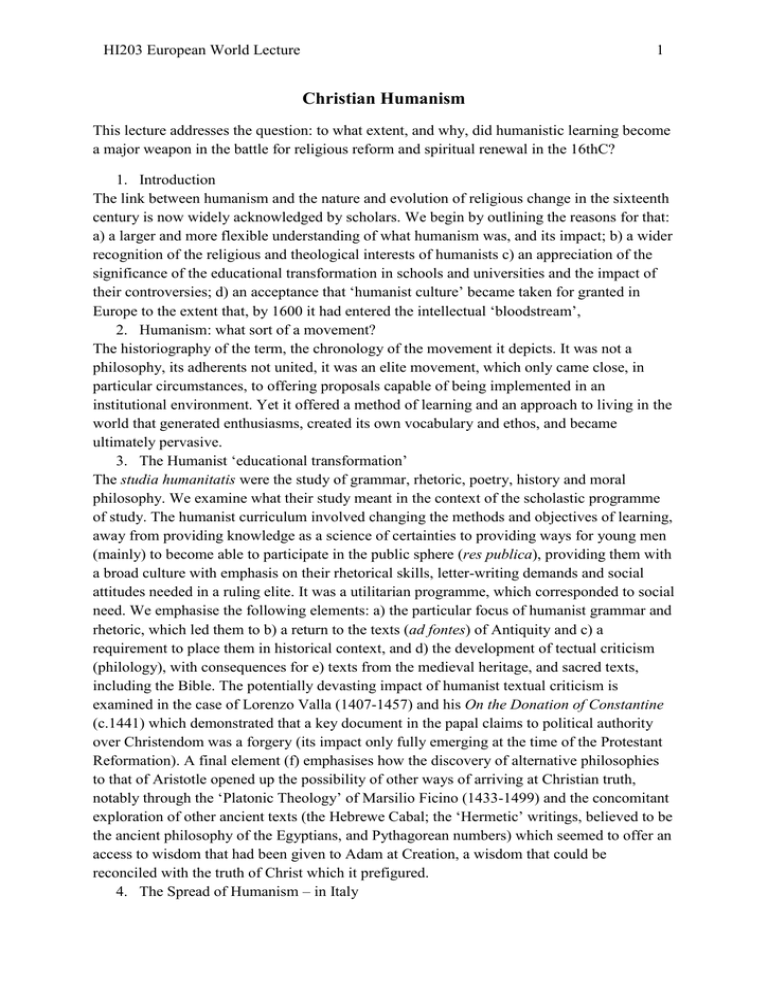
HI203 European World Lecture 1 Christian Humanism This lecture addresses the question: to what extent, and why, did humanistic learning become a major weapon in the battle for religious reform and spiritual renewal in the 16thC? 1. Introduction The link between humanism and the nature and evolution of religious change in the sixteenth century is now widely acknowledged by scholars. We begin by outlining the reasons for that: a) a larger and more flexible understanding of what humanism was, and its impact; b) a wider recognition of the religious and theological interests of humanists c) an appreciation of the significance of the educational transformation in schools and universities and the impact of their controversies; d) an acceptance that ‘humanist culture’ became taken for granted in Europe to the extent that, by 1600 it had entered the intellectual ‘bloodstream’, 2. Humanism: what sort of a movement? The historiography of the term, the chronology of the movement it depicts. It was not a philosophy, its adherents not united, it was an elite movement, which only came close, in particular circumstances, to offering proposals capable of being implemented in an institutional environment. Yet it offered a method of learning and an approach to living in the world that generated enthusiasms, created its own vocabulary and ethos, and became ultimately pervasive. 3. The Humanist ‘educational transformation’ The studia humanitatis were the study of grammar, rhetoric, poetry, history and moral philosophy. We examine what their study meant in the context of the scholastic programme of study. The humanist curriculum involved changing the methods and objectives of learning, away from providing knowledge as a science of certainties to providing ways for young men (mainly) to become able to participate in the public sphere (res publica), providing them with a broad culture with emphasis on their rhetorical skills, letter-writing demands and social attitudes needed in a ruling elite. It was a utilitarian programme, which corresponded to social need. We emphasise the following elements: a) the particular focus of humanist grammar and rhetoric, which led them to b) a return to the texts (ad fontes) of Antiquity and c) a requirement to place them in historical context, and d) the development of tectual criticism (philology), with consequences for e) texts from the medieval heritage, and sacred texts, including the Bible. The potentially devasting impact of humanist textual criticism is examined in the case of Lorenzo Valla (1407-1457) and his On the Donation of Constantine (c.1441) which demonstrated that a key document in the papal claims to political authority over Christendom was a forgery (its impact only fully emerging at the time of the Protestant Reformation). A final element (f) emphasises how the discovery of alternative philosophies to that of Aristotle opened up the possibility of other ways of arriving at Christian truth, notably through the ‘Platonic Theology’ of Marsilio Ficino (1433-1499) and the concomitant exploration of other ancient texts (the Hebrewe Cabal; the ‘Hermetic’ writings, believed to be the ancient philosophy of the Egyptians, and Pythagorean numbers) which seemed to offer an access to wisdom that had been given to Adam at Creation, a wisdom that could be reconciled with the truth of Christ which it prefigured. 4. The Spread of Humanism – in Italy HI203 European World Lecture 2 This section emphasises the role of humanist tutors, public schools, letter-writing, and printing, and especially the importance of humanism in the economy of publishing. 5. The Spread of Humanism – in transalpine Europe The mechanisms are similar to those in Italy, but the impact later and more variable. The differences are the not the result of varying contacts with Italy but the effect of a) the organisation of schools of learning north of the Alps (more organised opposition to humanism from the higher faculties); b) the impact of royal courts and princely aristocrats whose cultural tastes were not immediately engaged by the humanist agenda, and c) the difficult in equating the rediscovery of Latin antiquity with the cultural origins and foundational myths of polities north of the Alps. The result was that humanism spread within ‘micro-climates’. The significance of particular humanists operating in particular places is easily exaggerated. The ‘micro-climates’ which are evoked by way of examples are: St Lebwin’s School, Deventer (Nertherlands); the humanist library and grammar school at Sélestat (Alsace), and Saint Paul’s School, Westminster (founded by John Colet in 1509). The role of royal courts as patrons of humanist culture is also evoked through the example of Thomas More and the Utopia (1516) at the court of Henry VIII (a work about humanists in politics) and Guillaume Budé and his Institution of the Christian Prince (c.1519) at the court of François I (a work about how humanist learning prepared one for being a good citizen). 6. Humanism and Controversy In the two decades before the religious battles of the sixteenth century began in earnest, humanism in transalpine Europe ran the risk of becoming involved in public controversies that would damage fatally its own cause. That process is examined in the context of the Holy Roman Empire, which is where the battle would be joined first. The attempts to reform the syllabus at Erfurt and Wittemberg, both of which impacted on Luther, are briefly evoked. So too is the ‘battle of the books’ around Johannes Reuchlin (1455-1522) and the Letters of Obscure Men (1515, first edition) 7. Desiderius Erasmus: Humanist Hopes and Fears Realised Erasmus of Rotterdam (1467?-1536) embodied in his life and writings the hopes and fears of Christian humanists. The most admired humanist and religious reformer, he became also the most feared and attacked. His reputation was immense, and his impact on Protestant reformers, especially in the Rhineland and Swiss lands (Zwingli) considerable. His success was to bring together in his life and writings, humanist and non-humanist influences that would otherwise have remained local and weak. Through his humanist manuals first, and then through works devoted to public morality and popular devotion, he became a best seller, setting forth the ideal of the ‘philosophy of Christ’ and religious renewal from within. The hype which surrounded him, and which he partly encouraged, made him believe that peaceful change was possible. In reality, however, come the Protestant Reformation, Christian humanists had to choose which side they were on. Many chose to stay within the established church, and Christian humanism had as significant a role in Catholic renewal and revival as it did on Protestant reformers. The Reformations of the sixteenth century were essential to the transfusion of humanism into the cultural commonplace among educated Europe by 1600. M. Greengrass [m.greengrass@sheffield.ac.uk] 17 November 2015
